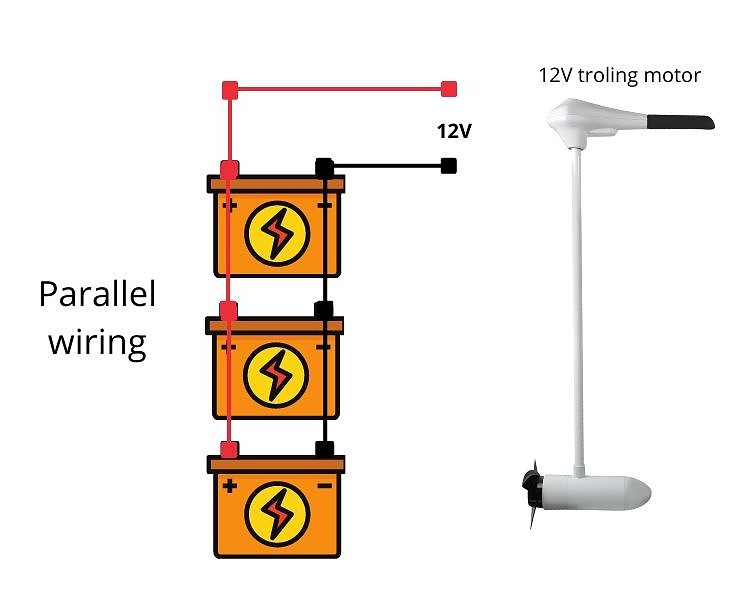When it comes to powering your trolling motor, chances are, you’ve run into one or both of the following problems.
Perhaps you have a 24- or 36-volt trolling motor but can only find 12-volt marine batteries. Or maybe your 12-volt battery is sufficient for your trolling motor but simply doesn’t last through the day on a single charge.
Each of these problems has a solution. For the first problem above, you can wire two or three batteries together in series. For the second, you can wire them together in parallel.
So what do those terms, “series” and “parallel” really mean?
Which wiring system is better, which one lasts longer, and which one gives the most power?
Keep reading!
In this article, we’ll answer all of these questions and more.
Table of Contents
- Is it Better to Connect Batteries in Series or Parallel?
- Does Series or Parallel Give More Power?
- Which Battery Lasts Longer, Series or Parallel?
- How Many Batteries Can Be Connected in Series?
- How Many Batteries Can Be Connected in Parallel?
- How to Connect Trolling Motor Batteries in Series
- How to Connect Trolling Motor Batteries in Parallel
- Conclusion
Is it Better to Connect Batteries in Series or Parallel?
It depends entirely on what you’re hoping to accomplish by wiring multiple batteries together. Let’s take a closer look at what each term means.
- Series. Connecting batteries in series means that the voltage is doubled or tripled while the battery capacity, or amp-hours, remains the same.
- Parallel. Connecting batteries in parallel means that the battery capacity is doubled or tripled while the voltage remains the same.
So, connecting in series will allow you to get the opposite results from connecting in parallel.
By connecting two 12V batteries in series, you can power a 24V trolling motor for the same amount of time that you could power a 12V trolling motor with one battery. By connecting three 12V batteries, you can power a 36V trolling motor in the same way.

If you have a 12V trolling motor, you may think that hooking up three 12V batteries in series will triple your battery life, but this is not the case. Instead, this would flood your trolling motor with 36 volts of power, likely melting the wiring and potentially causing a fire.
If you want to extend the run time of your trolling motor by using multiple batteries, you’ll need to connect them in parallel.
Say you’ve got a 12V trolling motor that always dies in the middle of your day on the water. If you don’t have an onboard charger, you’ll find yourself paddling or needing to be towed back to shore.
To double or triple the length of your battery life, you can wire two or three batteries in parallel. Wiring in parallel will not increase the voltage, but rather will increase the length of time your trolling motor can draw on the power source without exhausting the charge.

Wiring in series and in parallel are both generally safe practices as long as you follow a few safety guidelines.
- Understand the difference between series and parallel and only use the appropriate wiring for your situation. You wouldn’t want to connect multiple 12V batteries in series to power a 12V trolling motor, for example.
- Use identical batteries. It doesn’t work to wire a 12V battery to a 24V battery, and it’s best to use the same brand of battery so you can ensure they are the same.
- Make sure your batteries are fully charged before wiring them together. If they are unequally charged, the weaker battery will draw on the stronger battery, weakening the whole setup.
Does Series or Parallel Give More Power?
Wiring your batteries in series will produce a greater voltage output, thus giving you more power.
If you wire two 12V batteries in series, you will get 24 volts of power. If you wire three 12V batteries in series, you’ll get 36 volts of power. Four 12V batteries in series will produce 48 volts of power.
And so on.
So if your trolling motor needs a higher voltage than one battery can produce alone, you’ll want to wire multiple batteries together in series.
Which Battery Lasts Longer, Series or Parallel?

Wiring your batteries in parallel will increase your battery capacity, or available amp hours, thus giving you a longer run time.
Two 12V batteries wired in parallel will still produce 12 volts of power but will run for twice as long as one 12V battery. Three 12V batteries wired in parallel will run for three times as long. Four 12V batteries will give your four times the battery life.
So if you need to increase your battery life without increasing your voltage output, you’ll want to wire multiple batteries in parallel.
How Many Batteries Can Be Connected in Series?
When wiring your batteries in series, you can connect as many as necessary. Technically, there isn’t a limit to how many batteries can be wired in series, but you’ll want to be careful not to produce too large a voltage for your trolling motor or the wires being used.
Remember, wiring in series increases the voltage. If you find yourself having to wire more than four batteries, you might want to do some research to find if there are larger batteries you could be using instead.
Also, it’s a good idea to check with the battery manufacturer’s instructions for safety information about wiring your specific batteries in series.
How Many Batteries Can Be Connected in Parallel?
It is generally considered safe to wire up two four batteries together in parallel. Of course, that is assuming the batteries are all identical and equally charged.
The biggest problem encountered with wiring in parallel is having one weak battery that weakens the overall system. For this reason, it’s best not to combine new and old batteries, as the old batteries may lose a charge faster and drain the other batteries.
Again, read the manufacturer’s instructions before wiring batteries in parallel to make sure you don’t exceed the maximum recommended number of batteries.
How to Connect Trolling Motor Batteries in Series
To connect batteries in series, you’ll want to start by obtaining or making a set of jumper wires. If you plan to connect two batteries, you’ll need one jumper wire. For three batteries, you’ll need two wires, and so on.
Set your batteries in the appropriate place on your boat. You’ll want to secure them with battery boxes or mounts.
Connect your trolling motor’s negative lead to the negative terminal on the first battery. Then, using the jumper wires, connect the positive terminal on the first battery to the negative terminal on the second battery.
Repeat this process for as many batteries as you have.
Finally, connect the trolling motor’s positive lead to the positive terminal on the last battery.
Your batteries are now wired in series.
For a visual demonstration of how to connect batteries in series, check out this video.
How to Connect Trolling Motor Batteries in Parallel
For wiring in parallel, you will also need to use jumper wires (again, check out this video if you want to make them yourself).
Make sure your batteries are in the proper place and secured in your boat.
Connect the negative lead from your trolling motor to the negative terminal on the first battery, as you would for wiring in series. Then, using the jumper wires, connect all the batteries together negative terminal to negative terminal.
Repeat with the positive terminals. Hook up the trolling motor’s positive lead to the positive terminal on the first battery, then connect all of the positive terminals together with the jumper wires.
Your batteries are now wired in parallel.
This video gives you a good visual demonstration on how to connect your batteries in parallel.
Conclusion
Wiring your trolling motor batteries in series will give you greater voltage for the same battery capacity; wiring in parallel will give you greater battery capacity for the same voltage.
It’s as simple as that!
If you follow the steps in this guide, you should be able to easily wire your batteries either in series or in parallel, depending on whether you need a greater power output or longer battery life.
Happy boating!

Sarah Hood has been writing for Anchor Travel since 2021. When she’s not writing, she enjoys cooking, singing, and spending time in the great outdoors.

